

L'arte di Kandinsky spiegata ai bambini. Lezione del 16/03/2015 - DISCIPLINE PITTORICHE: le strutture (portante, modulare e proiettiva) del quadrato, triangolo equilatero e cerchio. Termine esercitazione con. (3 ore di Discipline pittoriche) - le strutture (portante, modulare e proiettiva) del quadrato, triangolo equilatero e cerchio. - Termine esercitazione con il mirino.
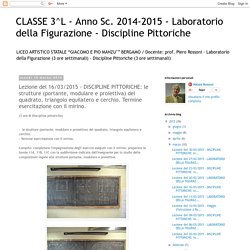
Compito: completare l'impaginazione degli esercizi eseguiti con il mirino; preparare le tavole 11A, 11B, 11C con la suddivisione indicata dall'insegnante per lo studio delle composizioni legate alle strutture portante, modulare e proiettiva. Pensare per immagini. La chiamiamo “civiltà dell’immagine” ma viviamo in un’epoca nella quale sconosciamo il linguaggio visivo e il suo utilizzo.
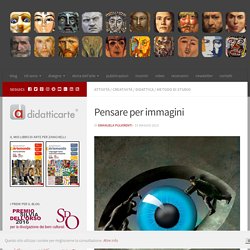
Non sappiamo sfruttare il potenziale visuale del nostro pensiero perché veniamo presto abituati ad un uso esclusivo del linguaggio verbale nell’apprendimento. La nostra cultura e la nostra educazione, infatti, sono fondate sulla parola. Con la parola definiamo e comprendiamo il mondo che ci circonda in modo talmente preciso e raffinato che abbiamo lentamente perso la capacità di elaborare immagini ed utilizzarle per accrescere le nostre competenze. Eppure l’intelligenza visivo/spaziale è una delle otto intelligenze ad oggi individuate dallo psicologo americano Howard Gardner, è presente in circa i 3/4 della popolazione ed è considerata la radice stessa del pensiero umano: prima di inventare la parola e poi la scrittura, la prima forma di espressione dell’uomo è stata l’immagine! Allora come allenare questa forma di intelligenza?
Grafiche programmate (Programmed Graphics) In 1961 Gruppo T was invited to contribute a series of Programmed Graphics according to cybernetic criteria for Almanacco Letterario Bompiani 1962, devoted to the “applications of electronic calculators to moral sciences and literature”.

Umberto Eco and Bruno Munari, the editors of the issue, used the concept of programmed art for the very first time here. Davide Boriani set up a series of logical processes in order to produce an ideally never-ending series of variations of a standard image: a photograph in colours of the portrait of Lucrezia Panciatichi by Agnolo Bronzino, divided into 400 equal modules. RE–PROGRAMMED ART 2014–15. Punto. Linea. Superficie. Kandinskij – CPIA 3 Rome. Per la creazione di un opera ( disegno, grafica, pittura) l’artista ( l’uomo che crea l’arte nelle sue varie forme: pittura, scrittura, poesia, musica … ) utilizza gli elementi fondamentali: punto,linea e superficie.
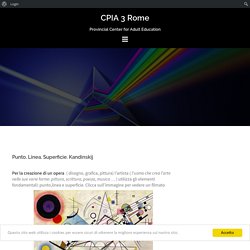
Clicca sull’immagine per vedere un filmato Video da youtube. Illustration - What is this circle technique called? - Graphic Design Stack Exchange. In all kinds of drawing, a formalised methodology has been attempted for centuries (ref.

The Vitruvian man). Rules and guidelines for proportions of the human body etc. have been drawn out for the use in architecture and art (and in some cases to hunt for the magic golden section). This, in a way, is an engineering approach to imagery: laying down basic guidelines. The examples you show kind of refers to that tradition. My guess is that the drawings you show are partly "reversed engineered" - someone doodled a lot, and then afterwards reconstructed the (seemingly sequential) process. ANIMALI COMPASSATI : materiali didattici. Behance. Illustrating Animals With 13 Circles: A Drawing Challenge And Tutorial. Editor’s Note: New year, new challenges!
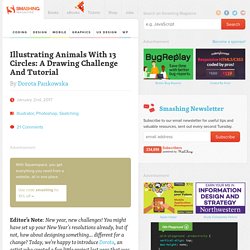
You might have set up your New Year’s resolutions already, but if not, how about designing something… different for a change? Today, we’re happy to introduce Dorota1, an artist who created a fun little project last year that was inspired by Twitter’s new logo based on 13 circles2. Awesome Circle Animal Logos With Tom Anders Watkins. Hi, today I have an aspiring logo designer for your inspiration.
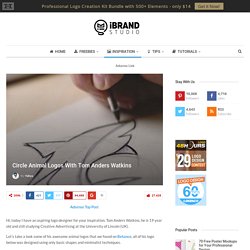
Tom Anders Watkins, he is 19 year old and still studying Creative Advertising at the University of Lincoln (UK). Let’s take a look some of his awesome animal logos that we found on Behance, all of his logo below was designed using only basic shapes and minimalist techniques. [afiliasilogodesignebook] 13 Animals Made From 13 Circles. 13 animali disegnati con solo 13 cerchi - Frizzifrizzi. Nel 2012 Twitter presentò il nuovo logo, una versione semplificata del già celebre uccellino blu realizzata — qua sta l’informazione che in questo momento ci interessa di più, al di là delle strategie di comunicazione — utilizzando soltanto 13 cerchi (per chi volesse approfondire, su design shack c’è un bel post che spiega tutto e mostra anche altre loghi disegnati in maniera simile, come ad esempio quello di Pepsi, di Apple e di iCloud).
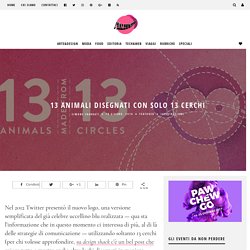
La designer e illustratrice Dorota Pankowska, polacca (credo) d’origine, canadese di nascita e parigina d’adozione, ispirata proprio dall’uccellino di Twitter ha deciso di accrescere il “bestiario” dei 13 cerchi utilizzando lo stesso concetto per creare altri animali — un gufo, un coniglio, una scimmietta, un elefante… — e mostrandone poi la struttura attraverso una serie di gif. © Dorota Pankowska. IL QUADRATO: COMPORRE E SCOMPORRE. Risoluzione DPI Pixel. A Periodic Table of Visualization Methods. Cut-Out Dress Sketches Completed With Urban Scenes – Fubiz Media. Be visual. Jt - joetex - percorsi didattici. Quick 15-minute Drawing from a SketchUp Model - Jim Leggitt / Drawing Shortcuts.
I love the challenge of creating conceptual drawings within extremely short time periods.

I also believe that every designer should develop the confidence to generate quick pen and ink sketches, add a splash of color and use those drawings when developing design concepts and communicating with clients. This “overlay and trace” drawing was created in less than 15-minutes directly in front of a potential client during an interview for a new university project. Prior to the interview, I built the SketchUp model and printed the perspective model view. In front of a dozen people, I taped a piece of trace over the print and started drawing! The resulting image fifteen minutes later is shown below: Educational Technology and Mobile Learning: copyright resources. August 12, 2014 Now that the new school year is about to start, it would be great to devote a session with your students where you can talk to them about issues related to copyright and proper use of digital artifacts from the net.

This will definitely help them make better and informed decisions as to the kind of materials they are allowed to use in their work and provide them with practice on the different ways they can appropriately credit sources. This resourceful page embeds a wide variety of materials to use in this regard, browse through the items featured there and bookmark the ones you plan to use with your students. I am also sharing with you this wonderful graphic that debunks 5 myths about copyright infringement. You can print it off and use it in your class as well. Quando firmare i propri lavori e come farlo. L’eterna disputa del firmare le proprio foto o lavori di digital imaging è paragonabile alla “guerra” tra Canon Vs Nikon o tra Pc Vs Mac.
Ci sono pro e contro di ogni lato della medaglia e allo stesso tempo ci sono alcuni punti fissi che bisogna tenere a mente per ottenere il massimo dal proprio portfolio creativo on-line. La firma sulle proprie foto può diventare un’arma a doppio taglio. Da un lato può darvi visibilità e dall’altro può portarvi nel grigiore amatoriale Come in ogni cosa, è importante avere le idee chiare e quindi sapere il VERO perché del voler mettere una firma o una nota di copyright sulla propria immagine.
Grid and pixel.